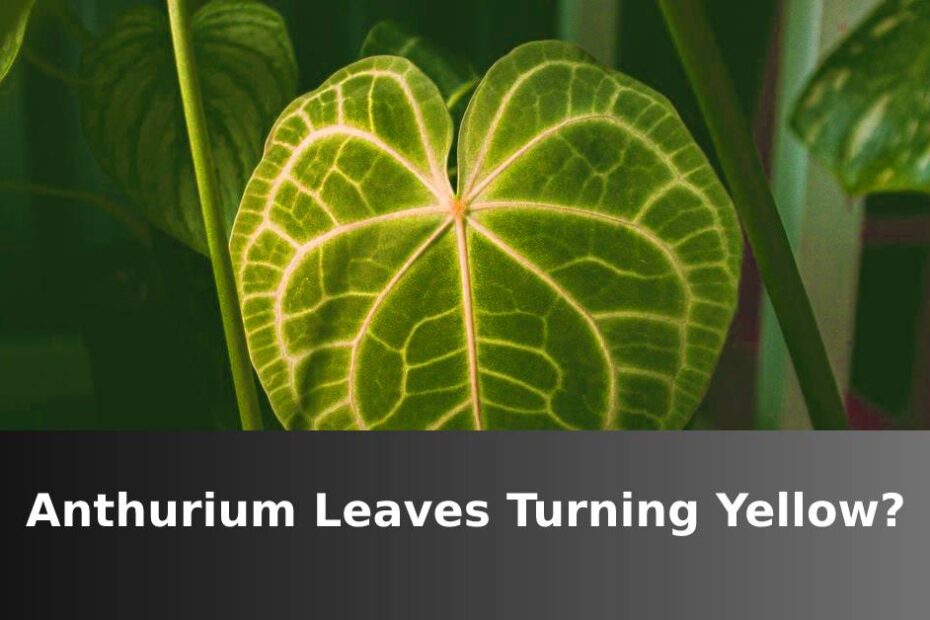Anthurium leaves turning yellow is often a sign that something is seriously wrong with your plant as this color indicates your Anthurium is very stressed.
This plant comes from a tropical environment, so you need to mimic the natural growing conditions as much as possible.
With that said, yellow leaves can be produced when growing conditions aren’t optimal but also from manual error which can easily happen if you’re new to growing plants.
So you’ve noticed the leaves on your Anthurium yellowing and you’re wondering what is causing this to happen.
Common causes for Anthurium leaves turning yellow include overwatering, too much direct light, low humidity levels, fertilizer burn and pests.
So let’s have a look at each of these issues to see which one is causing the discoloration in your leaves so you know what to do to correct the problem going forward.
Overwatering your Anthurium
The very most common cause for yellowing of the leaves will be caused by overwatering the plant or by using soil that doesn’t drain well as these two are connected.
In either case, the roots will become blocked by standing water and not be given oxygen needed to provide the nutrients your plant will need to thrive.
This can cause discoloration on the foliage such as yellow and then brown leaves, which eventually lead to root rot over time which will do further damage to your Anthurium if not taken care of immediately.
When it comes to watering this plant, you should wait until the soil is near completely dried out before you do so and a good way to tell when it’s time to water will be when the first few inches of soil towards the top have become dry.
This will ensure that the vast majority of the soil has dried out but the plant can still stay slightly moist towards the bottom but not waterlogged or anything like that.
When it comes to soil you want a good soil mix that drains well such as peat moss and perlite combined for adequate drainage.
After all of this is said and done, you should remove the leaves that turned yellow and check the roots for rot.
Direct light
Another cause for yellowing of the leaves can be attributed to direct sunlight or full sun.
Anthurium plants do not like this type of sunlight and would much rather get lots of bright but indirect light just like their natural growing environment would be like.
Even low light conditions will be better than the harsh sun when this plant is exposed to direct light.
If your Anthurium is exposed to direct light for too long you may notice yellowing of the leaves before they get entirely sunburnt and get brown spots or just turn brown at the very least.
If the damage has gotten that far then you will need to remove the affected leaves so the plant can use less energy on these lost causes and more on fresh healthy growth.
Fertilizer burn
You may or may not have heard of this term before but it is real.
Using too much fertilizer or for too long can cause and excess buildup of salts in the soil which will damage the roots of your plant, causing yellowing of the leaves and brown spots as a result of the damage.
Anthurium plants really don’t require all that much fertilizer and fertilizing every few months with a quarter strength of the recommended amount will be plenty for this plant.
If you suspect that you have been feeding the plant too much, you should flush the soil out to get rid of the excess salts that are damaging your otherwise healthy Anthurium.
Next time just use less and fertilize only once a month during the growing season at most so you don’t run the chance of having this issue in the future.
Low humidity
Anthurium plants love to be grown in warm and humid environments and so if your house or growing area gets too dry then this can cause discoloration for your plant.
If you find that your house is too dry normally then you can either begin growing outdoors, especially if you live in the South or you can try using a humidifier indoors to keep those levels up.
Pests
Pests are super annoying in general and can also cause some serious damage to all kinds of plants.
They can also be a major cause of your Anthurium leaves turning yellow.
Pests such as mealybugs, scales, aphids and spider mites can invade, feed on your plant, spread to to other plants and eventually cause your Anthurium plant to die if not dealt with.
These pests can cause yellowing of the leaves by feeding on the sap, taking nutrients from the plant and leaving the plant dehydrated overall.
You may notice yellow spots at first before the entire leaves become yellow from the damage.
With pests, you most likely will see holes in the leaves, and or your Anthurium can become sticky from honeydew left behind.
Unfortunately you may not be able to see the pests with your own eyes as many are them are so small that they are not visible.
However, you may be able to see white fuzzy spots or web like material which are sure signs you have a pest problem.
To treat an Anthurium with pests you can use a high quality neem oil spray or a cotton swab with rubbing alcohol to get rid of most pests.
If you’re using neem then you should only use it at night and let it dry so it doesn’t burn the leaves.
Also keep this plant away from other plants so the pests don’t have a chance to spread to the others during this time.
That’s really all there is to it.
